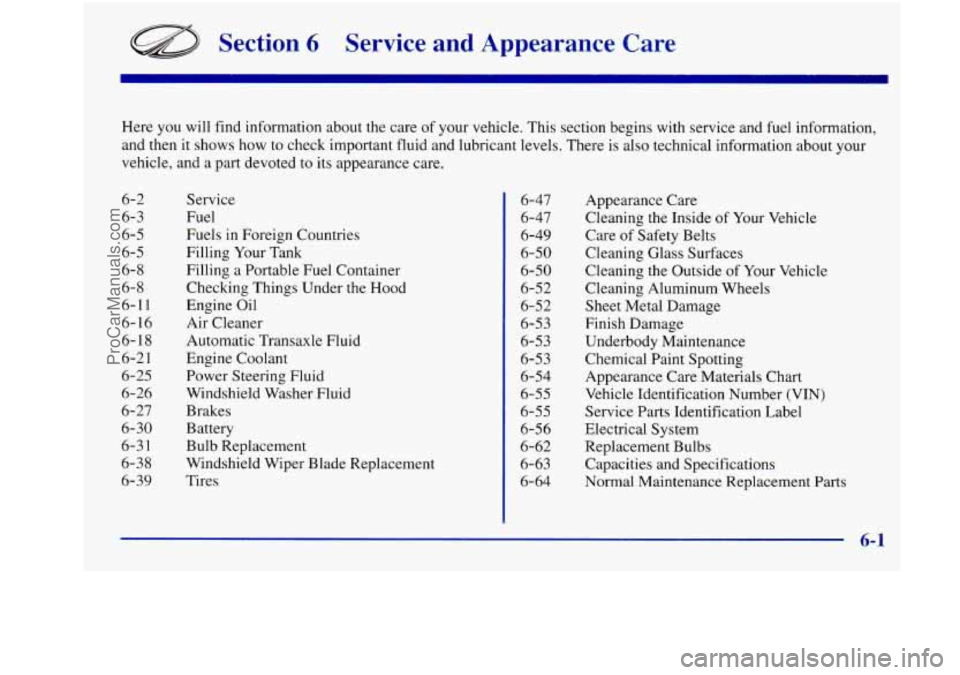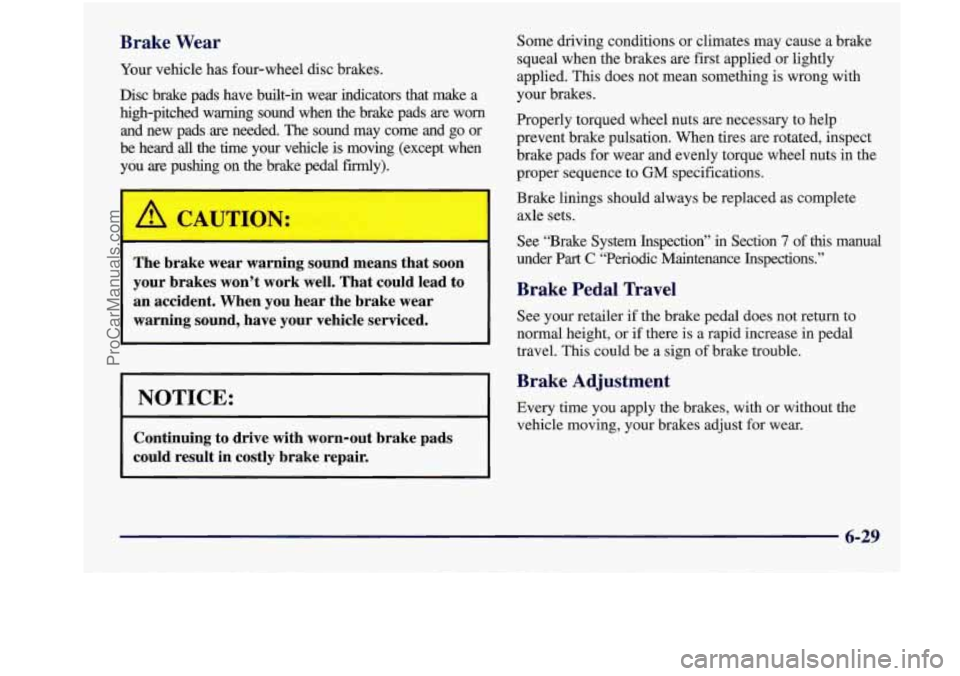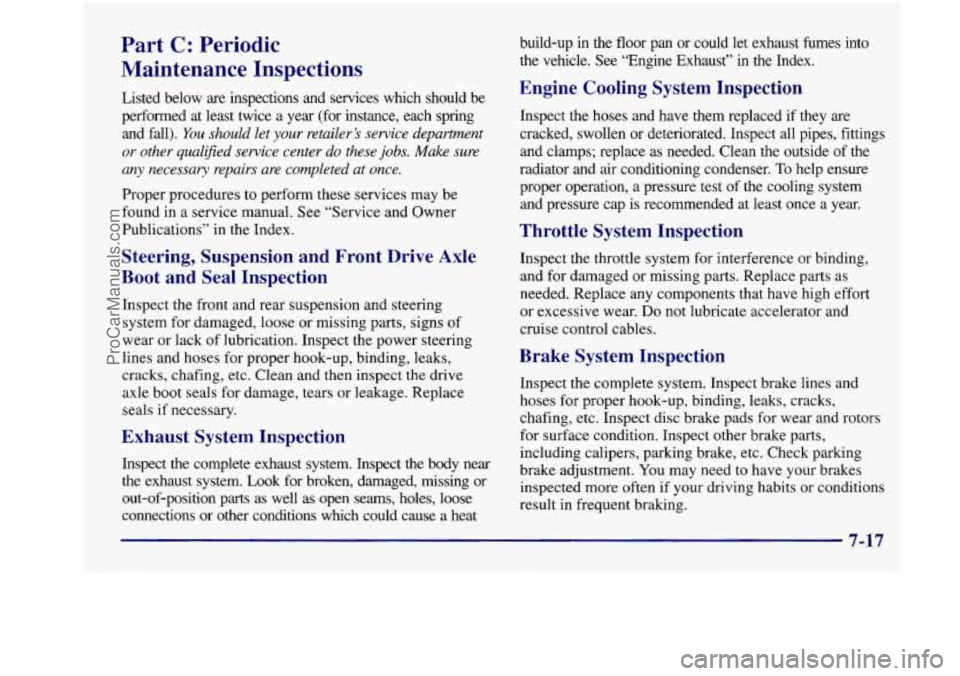brakes OLDSMOBILE INTRIGUE 1998 Owner's Manual
[x] Cancel search | Manufacturer: OLDSMOBILE, Model Year: 1998, Model line: INTRIGUE, Model: OLDSMOBILE INTRIGUE 1998Pages: 340, PDF Size: 17.93 MB
Page 191 of 340

When You Are Ready to Leave After
Parking on a Hill
1. Apply your regular brakes and hold the pedal down
while you:
Start your engine;
Shift into a gear; and
Release the parking brake.
2. Let up on the brake pedal.
3. Drive slowly until the trailer is clear of the chocks.
4. Stop and have someone pick up and store the chocks.
Maintenance When Trailer Towing
Your vehicle will need service more often when you’re
pulling a trailer. See the Maintenance Schedule for more
on this. Things that are especially important in trailer
operation are automatic transaxle fluid (don’t overfill),
engine oil, drive belts, cooling system and brake
adjustment. Each of these
is covered in this manual,
and the Index will help you find them quickly. If you’re
trailering, it’s a good idea to review this information
before you start your trip.
Check periodically to see that all hitch nuts and bolts
are tight.
Engine Cooling When Trailer Towing
Your cooling system may temporarily overheat during
severe operating conditions. See “Engine Overheating”
in the Index.
4-37
ProCarManuals.com
Page 229 of 340

Section 6 Service and Appearance Care
Here you will find information about the care of your vehicle. This section begins with service and fuel information,
and then it shows how
to check important fluid and lubricant levels. There is also technical information about your
vehicle, and a part devoted to its appearance care.
6-2 Service
6-3 Fuel
6-5 Fuels in Foreign Countries
6-5 Filling Your Tank
6-
8 Filling a Portable Fuel Container
6-
8 Checking Things Under the Hood
6-1 1 Engine Oil
6-
16 Air Cleaner
6-18 Automatic Transaxle Fluid
6-2
1 Engine Coolant
6-25 Power Steering Fluid
6-26 Windshield Washer Fluid
6- 27 Brakes
6-30 Battery
6-38 Windshield Wiper Blade Replacement
6-3
1 Bulb Replacement
6-39 Tires 6-47
6-47
6-49
6-50
6-50
6-52
6-52
6-53
6-53
6-53
6-54
6-55
6-55
6-56
6-62
6-63
6-64 Appearance
Care
Cleaning the Inside of Your Vehicle
Care of Safety Belts
Cleaning Glass Surfaces
Cleaning the Outside of Your Vehicle
Cleaning Aluminum Wheels
Sheet Metal Damage
Finish Damage
Underbody Maintenance Chemical Paint Spotting
Appearance Care Materials Chart
Vehicle Identification Number (VIN)
Service Parts Identification Label
Electrical System
Replacement Bulbs Capacities and Specifications
Normal Maintenance Replacement
Parts
6-1
ProCarManuals.com
Page 255 of 340

Brakes
Brake Fluid
goes back up. The other reason is that fluid is leaking out
of the brake system. If it is, you should have your brake
system fixed, since a leak means that sooner or later your
brakes won’t work
well, or won’t work at all.
So, it isn’t a good idea to “top off’ your brake fluid.
Adding brake fluid won’t correct
a leak. If you add fluid
when your linings are worn, then you’ll have too much
fluid when you get new brake linings. You should add
(or remove) brake fluid,
as necessary, only when work is
done on the brake hydraulic system.
Your brake master cylinder reservoir
is here. It is filled
with
DOT-3 brake fluid.
There are only two reasons why the brake fluid level
in the
reservoir might go down. The first is that the brake fluid
goes down to
an acceptable level during normal brake
lining wear.
When new linings are put in, the fluid level
If’ you have too much brake fluid, it can spa on the
engine. The fluid
will burn if‘ the engine is hot
enough. You or others could be burned, and
your
vehicle could be damaged. Add brake fluid only
when work
is done on the brake hydraulic system.
When your brake fluid falls to a low level, your brake
warning light will come on. See “Brake System Warning
Light”
in the Index.
6-27
ProCarManuals.com
Page 256 of 340

What to Add
When you do need brake fluid, use
only DOT-3 brake
fluid -- such as Delco Supreme ll@ (GM Part
No. 12377967). Use new brake fluid from a sealed
container only.
Always clean the brake fluid reservoir cap and
the area
around the cap before removing it. This
will help keep
dirt from entering the reservoir.
With the wrong kind
of fluid in your brake
system, your brakes may
not work well, or they
may not even work at all. This could cause
a
crash. Always use the proper brake fluid.
-- 1
NOTICE:
Using the wrong fluid can badly damage
brake system parts. For example, just
a few
drops of mineral-based oil, such as engine
oil, in your brake system can damage brake
system parts
so badly that they’ll have to be
replaced. Don’t let someone put in the
wrong kind of fluid.
0 If you spill brake fluid on your vehicle’s
painted surfaces, the paint finish can be
damaged. Be careful not
to spill brake fluid
on your vehicle. If you do, wash it off
immediately. See “Appearance Care” in
the Index.
6-28
ProCarManuals.com
Page 257 of 340

Brake Wear
Your vehicle has four-wheel disc brakes.
Disc brake pads have built-in wear indicators that make a
high-pitched warning sound when the brake pads are worn and new pads are needed. The sound may come and
go or
be heard all the time your vehicle is moving (except when
you are pushing on the brake
pedal firmly).
- m--
A CAUTION:
I
The brake wear warning sound means that soon
your brakes won’t work well. That could lead to
an accident. When you hear the brake wear
warning sound, have your vehicle serviced.
NOTICE:
Continuing to drive with worn-out brake pads
could result in costly brake repair.
Some driving conditions or climates may cause a brake
squeal when the brakes are first applied or lightly
applied. This does not mean something is wrong with
your brakes.
Properly torqued wheel nuts are necessary to help
prevent brake pulsation. When tires are rotated, inspect
brake pads for wear and evenly torque wheel nuts in the
proper sequence to
GM specifications.
Brake linings should always be replaced as complete
axle sets.
See “Brake System Inspection” in Section
7 of this manual
under Part
C “Periodic Maintenance Inspections.”
Brake Pedal Travel
See your retailer if the brake pedal does not return to
normal height, or if there is
a rapid increase in pedal
travel. This could be a sign of brake trouble.
Brake Adjustment
Every time you apply the brakes, with or without the
vehicle moving, your brakes adjust for wear.
6-29
ProCarManuals.com
Page 258 of 340

Replacing Brake System Parts
The braking system on a modern vehicle is complex.
Its many parts have to be of top quality and work well
together if the vehicle is
to have really good braking.
Your vehicle was designed and tested with top-quality
GM brake parts. When you replace parts of your braking
system
-- for example, when your brake linings wear
down and you have to have new ones put in
-- be sure
you get new approved
GM replacement parts. If you
don’t, your brakes may no longer work properly. For
example, if someone puts in brake linings that are wrong
for your vehicle, the balance between your front and
rear brakes can change
-- for the worse. The braking
performance you’ve come to expect can change in many
other ways if someone puts in the wrong replacement
brake parts.
cvery new Oldsmobile has an ACDelco Freedom@
battery. You never have to add water to one of these.
When it’s time for a new battery, we recommend
an ACDelco Freedom battery. Get one that has
the replacement number shown
on the original
battery’s label.
Vehicle Storage
If you’re not going to drive your vehicle for 25 days or
more, remove the black, negative (-) cable from
the battery. This will help keep your battery from
running down.
Batteries have acid that can burn you and gas
that can explode. You can be badly hurt if you
aren’t careful. See “Jump Starting” in the Index
for tips on working around a battery without
getting hurt.
Contact your retailer to learn how to prepare your
vehicle for longer storage periods.
Also,
for your audio system, see “Theft-Deterrent
Feature”
in the Index.
6-30
ProCarManuals.com
Page 297 of 340

I Maintenance Schedule I
The services shown in this schedule up to 100,000 miles
(I 66 000 km) should be performed after 100,000 miles
(1
66 000 km) at the same intervals. The services shown
at
150,000 miles (240 000 km) should be performed at
the same interval after
150,000 miles (240 000 km).
See “Owner Checks and Services” and “Periodic
Maintenance Inspections” following.
Footnotes
? The U.S. Environmental Protection Agency or the
California Air Resources Board has determined that the
failure to perform this maintenance item will not nullify
the emission warranty or limit recall liability prior to
the completion of the vehicle‘s useful life. We, however,
urge that all recommended maintenance services
be performed at the indicated intervals and the
maintenance be recorded.
* Your vehicle has an Engine Oil Life Monitor. This
monitor will show
you when to change the engine oil
and filter
-- usually between 3,000 miles (5 000 km)
and
7,500 miles (12 500 km) since your last oil change.
Under severe conditions, the indicator may come on
before
3,000 miles (5 000 km). Never drive your vehicle
more than
7,500 miles (12 500 km) or 12 months
without an oil and filter change.
The system won’t detect dust in the oil.
So if you
drive
in a dusty area, be sure to change your oil and
filter every
3,000 miles (5 000 km) or sooner if the
CHANGE
OIL light comes on. Remember to reset the
Oil Life Monitor when the oil has been changed.
For
more information, see “Engine Oil” in the Index.
+ A good time to check your brakes is during tire
rotation. See “Brake System Inspection’’ unde.r “Periodic
Maintenance Inspections” in Part C
of this schedule.
7-5
ProCarManuals.com
Page 308 of 340

Ignition Transaxle Lock Check
While parked, and with the parking brake set, try to turn
the ignition key to
OFF in each shift lever position.
The key should turn to OFF only when the shift lever
is in PARK (P).
0 The key should come out only in OFF.
Parking Brake and Automatic Transaxle PARK (P)
Mechanism Check
When you are doing this check, your vehicle
could begin to move. You or others could be
injured and property could be damaged. Make
sure there is room in front of your vehicle in case
it begins to roll. Be ready to apply the regular
brake
at once should the vehicle begin to move.
Park on a fairly steep hill, with the vehicle facing
downhill. Keeping your foot on the regular brake, set the
parking brake.
0 To check the parking brake’s holding ability: With
the engine running and transaxle in
NEUTRAL (N),
slowly remove foot pressure from the regular brake
pedal.
Do this until the vehicle is held by the parking
brake only.
0 To check the PARK (P) mechanism’s holding ability:
With the engine running, shift to PARK
(P). Then
release
all brakes.
Underbody Flushing Service
At least every spring, use plain water to flush any
corrosive materials from the underbody. Take care
to clean thoroughly any areas where mud and other
debris can collect.
7-16
ProCarManuals.com
Page 309 of 340

Part C: Periodic
Maintenance Inspections
Listed below are inspections and services which should be
performed at least twice a year (for instance, each spring
and fall).
You should let your retailer’s service department
or other qualiJied service center do these jobs. Make sure
any necessary repairs are completed at once.
Proper procedures to perform these services may be
found in a service manual. See “Service and Owner
Publications” in the Index.
Steering, Suspension and Front Drive Axle
Boot and Seal Inspection
Inspect the front and rear suspension and steering
system for damaged, loose or missing parts, signs of
wear or lack of lubrication. Inspect the power steering
lines and hoses for proper hook-up, binding, leaks,
cracks, chafing, etc. Clean and then
axle boot seals for damage, tears or
seals if necessary.
Exhaust System Inspection
Inspect the complete exhaust system. inspect
the drive
leakage. Replace
Inspect the body near
the exhaust system. Look for broken, damaged, missing
or
out-of-position parts as well as open seams, holes, loose
connections or other conditions which could cause a heat build-up in
the floor
pan or could let exhaust fumes into
the vehicle. See “Engine Exhaust” in the Index.
Engine Cooling System Inspection
Inspect the hoses and have them replaced if they are
cracked, swollen or deteriorated. Inspect all pipes, fittings
and clamps; replace as needed. Clean the outside
of the
radiator and air conditioning condenser.
To help ensure
proper operation, a pressure
test of the cooling system
and pressure cap
is recommended at least once a year.
Throttle System Inspection
Inspect the throttle system for interference or binding,
and for damaged or missing parts. Replace parts as
needed. Replace any components that have high effort
or excessive wear. Do not lubricate accelerator and
cruise control cables.
Brake System Inspection
Inspect the complete system. Inspect brake lines and
hoses for proper hook-up, binding, leaks, cracks,
chafing, etc. Inspect disc brake pads for wear and rotors
for surface condition. Inspect other brake parts,
including calipers, parking brake, etc. Check parking
brake adjustment. You may need to have your brakes
inspected more often if your driving habits
or conditions
result in frequent braking.
7-17
ProCarManuals.com
Page 324 of 340

1998 OLDSMOBILE SERVICE PUBLICATIONS ORDERING INFORMATION
The following publications covering the operation and servicing of your vehicle can be purchased by filling out
the Service Publication Order Form in this book and mailing it\
in with your check, money order,
or credit card information to Helm, Incorporated (address below.)
CURRENT PUBLICATIONS FOR 1998 OLDSMOBILE
SERVICE MANUALS
Service Manuals have the diagnosis and repair information
on engines, transmission, axle, suspension, brakes,
electrical, steering, body, etc. RETAIL SELL PRICE: $90.00
TRANSMISSION, TRANSAXLE, TRANSFER CASE UNIT REPAIR MANUAL
This manual provides information on unit repair service
procedures, adjustments and specifications for the
1998 GM transmissions, transaxles and transfer cases.
RETAIL SELL PRICE: $40.00
SERVICE BULLETINS
Service Bulletins give technical service information needed
to knowledgeably service General Motors cars and trucks.
Each bulletin contains instructions to assist in the
diagnosis and service of your vehicle.
PLEASE COMPLETE THE ORDER FORM SHOWN ON
THE FOLLOWING PAGE AND MAIL
TO:
Helm, Incorporated P.O. Box 07130 Detroit, MI 48207
OWNER’S INFORMATION
Owner publications are written directly for Owners and
intended to provide basic operational information about the
vehicle. The owner’s manual will include the Maintenance
Schedule for all models.
In-Portfolio: Includes a Portfolio, Owner’s Manual and
Warranty Booklet. RETAIL SELL PRICE:
$1 5.00
Without Portfolio: Owner’s Manual only.
RETAIL SELL PRICE:
$1 0.00
CURRENT & PAST MODEL ORDER FORMS
Service Publications are available for current and past
model GM vehicles. To request an order form, please
specify year and model name of the vehicle.
OR ORDER TOLL FREE: 1-800-782-4356
Monday-Friday 8:OO AM - 6:OO PM Eastern Time
For Credit Card Orders Only
(VISA-MasterCarcGDiscover)
ProCarManuals.com